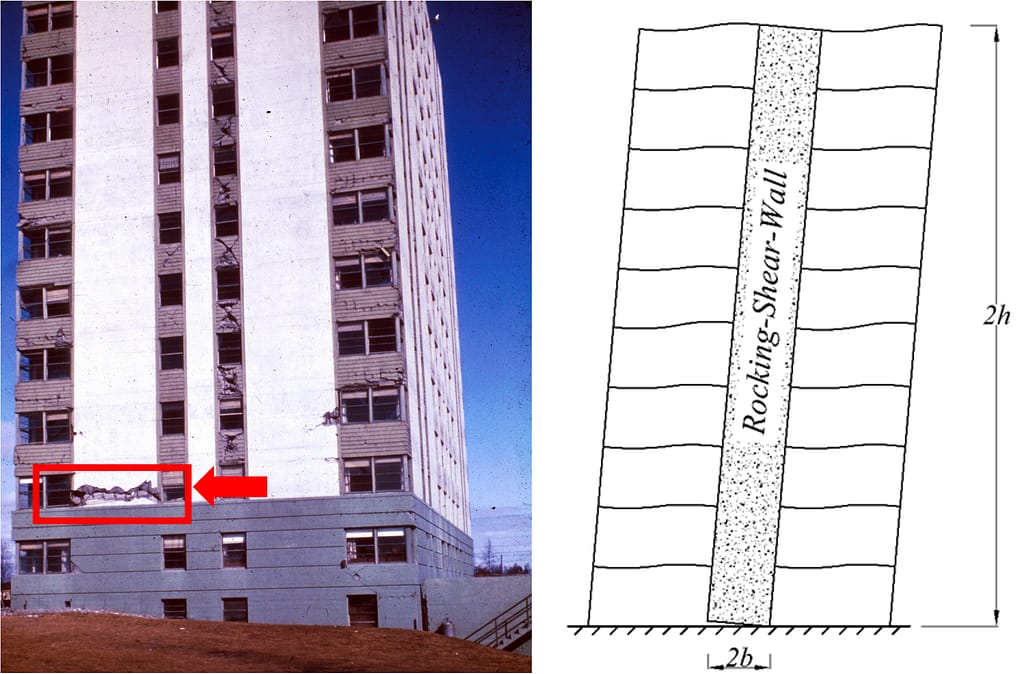
Seismic Response of Moment Resisting Frames when Coupled with a Rocking Wall
In view of the appreciable seismic damage and several weak-story failures (some at mid-height) of multistory buildings that have been documented after major earthquakes, there has been a growing effort to develop an alternative hybrid structural system by coupling the response of moment resisting frames with rigid/stiff walls which are allowed to uplift and rock during ground shaking; therefore, enforcing a uniform drift distribution.
In this topic, the sehm lab conducted series of studies to understand the behavior of moment resisting frames when coupled with rocking walls with different configurations. These studies are published in various journals and presented in conferences.

Structural Health Monitoring
Considering the state of current infrastructure and the importance of timely maintenance in order to keep these infrastructure operable for longer, it is important to develop methods of real-time health monitoring and damage detection. The aim of this work is to develop a framework through an experimental and numerical study to create physics-based digital twin for civil infrastructure to predict their behavior based on the future instances.
For this purpose this lab conducted various health monitoring projects ranging from stadiums, bridges, and energy infrastructure.

High-Fidelity Finite Element Analysis using Substructuring Techniques
Over time, an increase in computational power has enabled modeling and analysis of finite element models (FEMs) with greater detail. However, even with the high-performance computers, the analysis of high-fidelity FEMs is still computationally expensive. Hence, the use of high-fidelity FEMs, especially for model updating purposes, can be cumbersome. To overcome these challenges, notably if the dynamic characteristics like eigenvalues, eigenmodes, and frequency-responses are the outputs of interest, component mode synthesis (CMS) methods are employed.

Bridge Piers that are Free to Rock and Rotate above their Foundation
The concept of allowing a tall, slender structure to uplift and rock was first advanced and implemented in modern civil engineering in the late 1960s in New Zealand with the design and construction of the stepping piers of the South Rangitikei Rail Bridge. Despite its remarkable design and its half-century-long outstanding seismic performance, the stepping design of the South Rangitikei Rail Bridge has not received the attention it deserves because even at present the design of nearly all tall valley bridges remains entrenched in capacity design, leading to disproportionally large and expensive pile or caisson foundations.
On the topic of rocking bridge-piers with supplemental dampers our paper was awarded the 2020 ASCE J. James R. Croes Medal.

Explaining the Destruction of Monumental Architecture
The goal of this project is to increase understanding ancient societies by examining the destruction of monumental architecture. This research focuses on sites where hundreds of massive, stone statues were carved, transported, erected, and subsequently toppled over. Popular accounts have attributed the destruction of statues to a chaotic period of warfare and societal collapse. It has also been suggested statues may have been toppled by neglect, or strong earthquakes. The research team comprised of archaeologists, a seismologist, and civil engineers are working closely with students in conducting this research. The project serves to enhance indigenous cultural understanding and the results are anticipated to form the basis of a consensus explanation for this case study and promote related inquiry elsewhere. NSF funded project, Award Number: 2401213. [link]

Student Research
If you are interested in research please feel free to email me or stop by my office.